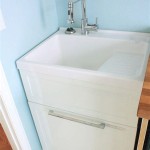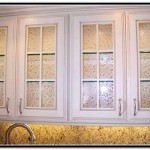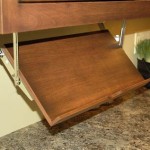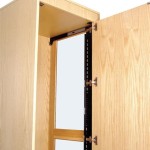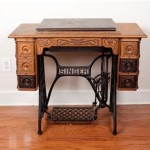How to Clean Sticky Wood Cabinets
Sticky wood cabinets are a common household nuisance, often resulting from accumulated grease, food splatters, dust, and general grime. The stickiness not only detracts from the aesthetic appeal of the kitchen or bathroom but can also harbor bacteria and become difficult to remove over time if left unaddressed. Understanding the causes of this stickiness and implementing proper cleaning techniques are crucial to maintaining the beauty and hygiene of wood cabinets.
The buildup on wood cabinets typically occurs gradually. Cooking oils and fats, aerosolized during cooking, settle on the surfaces. These oils then attract dust and other airborne particles, creating a sticky layer. Fingerprints, spills, and splashes also contribute to the problem. The porous nature of wood further exacerbates the issue, as it allows substances to penetrate the surface, making the sticky residue more difficult to remove.
Regular cleaning is the best preventative measure. Wiping down cabinets after cooking can significantly reduce the accumulation of grime. However, even with diligence, a more thorough cleaning is periodically necessary. The following sections detail effective methods for cleaning sticky wood cabinets, emphasizing gentle yet effective approaches to preserve the wood's finish.
Identifying the Type of Finish
Before initiating any cleaning process, it is crucial to identify the type of finish applied to the wood cabinets. Different finishes require different cleaning approaches to avoid damage. Common finishes include varnish, lacquer, polyurethane, and painted surfaces. Some cabinets may also have a simple wax finish.
Varnish, lacquer, and polyurethane finishes are typically more durable and water-resistant, allowing for the use of slightly more aggressive cleaning solutions. Painted surfaces, while often durable, can be susceptible to scratching and chipping, requiring gentle handling. Wax finishes are the most delicate and require specialized cleaning methods to avoid stripping the wax layer.
A simple test can help determine the type of finish. In an inconspicuous area, such as the inside of a cabinet door, gently rub a small amount of mineral spirits onto the surface. If the finish dissolves or becomes sticky, it is likely a lacquer finish. If the mineral spirits have no effect, the finish is likely varnish, polyurethane, or paint. If the cabinet leaves a waxy residue on your finger when rubbed in an inconspicuous area, it likely has a wax finish.
Once the type of finish is identified, choose a cleaning method appropriate for that finish. Using the wrong cleaning solution can damage the finish, resulting in discoloration, cloudiness, or even complete removal of the protective layer.
Gentle Cleaning Solutions and Methods
The initial approach to cleaning sticky wood cabinets should involve the gentlest possible methods. Starting with mild solutions minimizes the risk of damage and often effectively removes the accumulated grime. The following are several gentle cleaning options:
Warm Water and Dish Soap: This is the most basic and often effective cleaning solution. Mix a small amount of mild dish soap with warm water. Use a soft cloth or sponge to wipe down the cabinets, working in the direction of the wood grain. Rinse the cloth frequently and wring out excess water to prevent saturation of the wood. After washing, wipe the cabinets with a clean, damp cloth to remove any soap residue, and then dry them thoroughly with another clean, dry cloth.
Vinegar and Water: Vinegar is a natural degreaser and disinfectant. Mix equal parts white vinegar and warm water in a spray bottle. Lightly spray the solution onto the cabinets and let it sit for a few minutes to loosen the grime. Wipe the cabinets with a soft cloth, rinsing and wringing it frequently. Follow with a clean, damp cloth to remove any vinegar residue, and dry thoroughly. It is important to note that while vinegar is generally safe, prolonged exposure to acidic solutions can damage certain finishes. Test in an inconspicuous area first.
Baking Soda Paste: For more stubborn sticky spots, a baking soda paste can be effective. Mix baking soda with a small amount of water to create a thick paste. Apply the paste to the sticky areas and gently rub with a soft cloth. Be cautious not to scrub too hard, as baking soda can be abrasive. Wipe away the paste with a damp cloth and dry thoroughly. This method is particularly effective for removing grease splatters.
Oil Soap: Oil soap products, specifically designed for wood cleaning, can be used to gently clean and condition wood cabinets. Follow the manufacturer's instructions carefully. Generally, you will dilute the oil soap with water and apply it to the cabinets with a soft cloth. Wipe away any excess solution and dry thoroughly. Oil soap helps to replenish the natural oils in the wood, preventing it from drying out and cracking.
When using any of these solutions, always test in an inconspicuous area first to ensure it does not damage the finish. Avoid using abrasive sponges or scrub brushes, as they can scratch the surface. Work in small sections, rinsing and drying each section completely before moving on to the next.
Tackling Stubborn Stains and Grease Buildup
When gentle cleaning solutions prove insufficient for removing stubborn stains and heavy grease buildup, more targeted approaches are necessary. However, even with these methods, caution and testing are essential to avoid damaging the cabinet finish.
Commercial Degreasers: Several commercial degreasers are specifically formulated for kitchen cleaning. Choose a degreaser that is designed for use on wood and always follow the manufacturer's instructions. Apply the degreaser sparingly to the affected areas, allowing it to sit for the recommended time to loosen the grime. Wipe away the degreaser with a damp cloth and dry thoroughly. It is crucial to ventilate the area well when using commercial degreasers, as they can contain strong chemicals.
Mineral Spirits: Mineral spirits are a solvent that can effectively dissolve grease and grime. Dip a soft cloth into mineral spirits and gently rub the affected areas. Work in a well-ventilated area and wear gloves to protect your skin. After cleaning with mineral spirits, wipe the cabinets with a clean, damp cloth to remove any residue, and dry thoroughly. Mineral spirits are flammable and should be handled with care.
Homemade Citrus Cleaner: Citrus fruits, such as lemons and oranges, contain natural degreasing properties. Create a homemade citrus cleaner by steeping citrus peels in white vinegar for several weeks. Strain the vinegar and use it as a cleaning solution. Spray the solution onto the cabinets, let it sit for a few minutes, and wipe away with a clean cloth. The citrus scent also provides a pleasant aroma.
Steam Cleaning: A steam cleaner can be used to loosen stubborn grease and grime without the need for harsh chemicals. Use a steam cleaner with a nozzle attachment and direct the steam at the sticky areas. Wipe away the loosened grime with a clean cloth. Be careful not to hold the steam cleaner in one spot for too long, as excessive heat can damage the wood finish. Always test the steam cleaner in an inconspicuous area first.
For any stubborn stains, patience is key. Repeated applications of a gentle cleaner are often more effective than a single application of a harsh cleaner. If a stain persists after several attempts, consult a professional cabinet refinisher.
Maintaining clean and non-sticky wood cabinets requires a combination of preventative measures, gentle cleaning techniques, and targeted solutions for stubborn stains. By identifying the type of finish, using appropriate cleaning methods, and exercising caution, it is possible to preserve the beauty and longevity of wood cabinets for years to come. Regular maintenance will make the cleaning process easier and prevent the accumulation of sticky residue, ensuring a cleaner and more hygienic kitchen or bathroom environment.

How To Easily Clean Sticky Wood Kitchen Cabinets Creative Homemaking

How To Clean Sticky Wood Kitchen Cabinets A Complete Guide
How To Clean Sticky Wood Kitchen Cabinets Quora

How To Clean Kitchen Cabinets Everyday Skate

Clean Sticky Grease Off Laminate Wooden Kitchen Cabinets Above Stove Without Removing Finish

How To Easily Clean Sticky Wood Kitchen Cabinets Creative Homemaking

4 Proven Ways To Clean Sticky Wood Kitchen Cabinets Lovetoknow

How To Quickly Clean Cabinets Remove Grease Gunk Andrea Jean
How To Clean Kitchen Cabinets Without Damaging The Finish Quora

How To Clean Wood Cabinets And Make Them Shine
Related Posts


